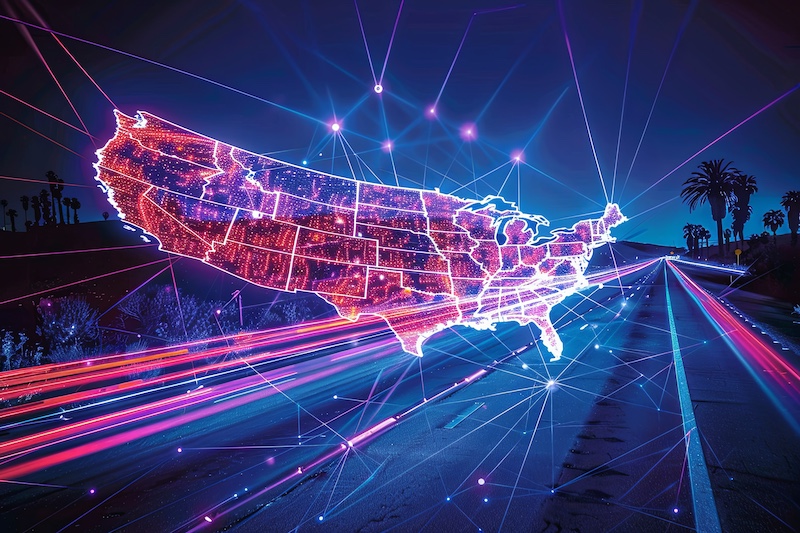In September 2024, legislators passed the California AI Transparency Act (SB 942), which will formally take effect on January 1, 2026. As a result, by this time next year, every synthetic surf-video of Malibu, each artificial intelligence (AI)-generated product shot, and the robo-voice hawking a new podcast will come stamped with a tell-tale signature.
SB 942 doesn’t place the burden on a single industry tier. Instead, it slices accountability three ways:
- Generative-AI developers: If an AI model serves over 1 million monthly users in California, the developer must watermark every image, video, or sound file the system exports (“latent disclosure”). They must also give end-users a one-click option to add a visible “Generated with AI” badge (“manifest disclosure”) and publish a free public detector that can spot the watermark. Civil fines run $5,000 per violation per day if you miss any of the above.
- Social media and other large-scale platforms: SB 942 leaves most of the watermark heavy-lifting to the creators, but its sibling measure — the Defending Democracy from Deepfake Deception Act (AB 2655) — steps in when elections loom. Any site or app with more than one million California users must roll out “state-of-the-art” tooling to spot and act on politically deceptive deepfakes. From 120 days before Election Day up through the vote itself, reported fakes that misrepresent candidates, election officials, or election outcomes have to come down; outside that window, the same content must at least carry a clear “manipulated” label. Platforms also have to give Californians an easy way to flag offenders and keep a paper trail for regulators and the courts.
- Third-party licenses: Political campaigns, ad shops, or anyone else who licenses a covered model must leave the watermarking stack intact. If a developer discovers that a client disabled the disclosures, they have 96 hours to kill access. Keep using the tool after that, and the license risks injunctions and another stack of fees.
How the Labeling Works
Latent disclosures are tiny cryptographic fingerprints hidden in pixel or audio data that survive basic editing and social-media compression. In comparison, manifest disclosures are what humans can see or hear — a corner glyph on an image, a banner under a video, or a brief spoken notice in synthetic audio.
Both layers share a unique content ID, allowing the state-mandated AI verification tool to cross-check them and flag tampering instantly. The statute directs vendors toward open standards like C2PA but permits them to choose any interoperable protocol.
Why May Matters for Developers, Platforms
The remaining time until SB 942 goes into effect may seem generous, at least until it comes time to start hard-coding watermark libraries into GPU pipelines or building rule-sets that keep badges alive through user edits, compression, and repost chains. The Attorney General’s guidance highlights three immediate tasks:
- Map every output path — API endpoints, batch renders, even demos — and make sure each one stamps content.
- Store provenance logs (model version, prompt harsh, timestamp) for at least three years.
- Launch an appeal workflow so creators can challenge false positives without going to court first.
Skip any step and the $5,000-per-violation-per-day meter starts running.
Early estimates from the Bay Area Council indicate that the engineering lift for a mid-sized model provider is roughly $400,000 in upfront development, plus an additional 5-7 percent increase in annual hosting costs to store provenance logs and run detection APIs. Even open‑source labs — often reliant on grant money — must divert talent from research to build watermark forks.
The silver lining is that once the plumbing exists, those same provenance hooks unlock premium features: “trust‑grade” subscription tiers for enterprise buyers, audit‑ready media trails for newsrooms, and content‑licensing deals that were previously too risky to sign.
A Ripple Effect Beyond California
Tech companies rarely maintain 49 different compliance playbooks. Once a watermarking pipeline exists for California, it is cheaper to leave it on everywhere. That is how the state’s privacy rules became a de facto U.S. baseline; most analysts believe AI labeling will follow the same path.
The European Union’s AI ACT — finalized this spring — requires watermarking but leaves the technical details open. California just supplied a functional blueprint, and Brussels now has something tangible to copy or tighten.
Transparency Isn’t a Save-all, Yet it Shifts the Ground
Labels alone will not stop every scam or deepfake. What they will do is give citizens, watchdogs, and courts one way to trace digital media back to the silicon that spawned it. Online trust has never been lower; SB 942 will not fix that overnight, but it finally puts a light switch on the wall.
For developers, marketers, and platform operators, the message is blunt: embed the water, surface the badge, and keep your audit logs neat. Transparency is no longer a brand virtue; in California, it’s the cost of doing business.



